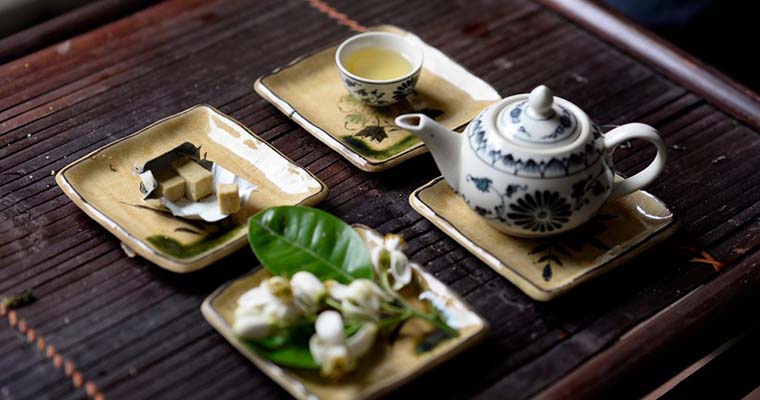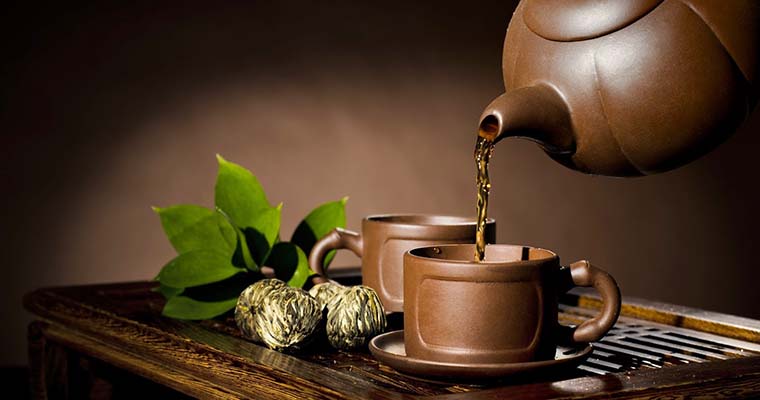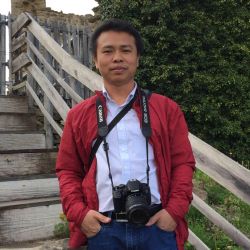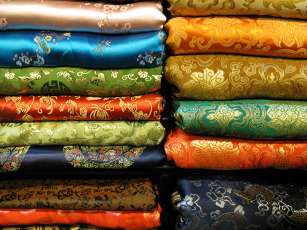
Vietnamese Tea
- on Jan 3, 2018 By: Ngoc Tu DINH
With over 2,000 years of tea making, Vietnam is one of the largest and oldest tea-producing countries in the world. Even though the history of Vietnamese tea has not been well recorded as that of the Chinese or Japanese, from the past until current days, tea drinking has played an essential role in Vietnamese culture. With a wide range of varieties, Vietnamese tea can be classified into three main types, known as green tea (“Tra xanh”), plain black tea (“Tra man”), and scented tea (“Tra uop huong”).
In this article, Authentik Travel take you in a trip to the prolific world of traditional Vietnamese tea!
Green tea – "Tra Xanh"
It could not come without mentioning green tea whenever one talks about Vietnamese culinary. Green tea has been ingrained extensively throughout every regions of Vietnam since the middle of the 20th century, and steadily turning into a symbol of ordinary life of Vietnam.

Fragment green tea
Being amiable to Vietnam’ soil and climate, green tea it can be widely found in not only plain but also highland areas and sometimes can be seen right in the family backyard’s gardens. With the higher trunk and larger of leaves in comparison with other tea plants, green tea can be served fresh. There is no need to wilt or oxidize; people can enjoy it right after picking the leaves from the tree. Just fifteen minutes steeping and boiling the tealeaves in hot water, your green tea is ready to be served.
With a tropical climate, Vietnam has been developed as an agricultural country, where people in rural area earn a living mainly from farming. The keeping-cool function makes green tea a perfect drink for summer days in this tropical land. Besides blowing out the heat from the insides, green tea also helps improving the body’s resistance to infection.
Unsurprisingly, green tea is an indispensable part of Vietnamese farmers’ ordinary life. Easy in preparing and serving, green tea is used everywhere; during the time break of farming day under the shade of green trees, or on a patio after long hard-working hours. The image of people gathering around in the small stall near the village gate, chatting merrily while drinking green tea served in porcelain bowls is a typical picture describing the lifestyle of countryside Vietnamese.
In the meanwhile, Vietnamese people also treat “nuoc voi” (made from a plant in Northern Vietnam) as a substitute for green tea. After being incubated in straw-covered basket and hard dried under the heat in open air, desiccated buds and leaves of “voi” tree will be served in the same way as green tea leaves.
In this day and age, owning up about Vietnamese ardor for green tea and its good effects on health, some shrewd producers have convert this folk beverage into canned drink, bringing green tea closer to urban citizens as well as foreigners.
Plain Black tea - "Tra Man"
It takes quite much time and great effort to have a thorough perception of Vietnam’s “Trà mạn” - plain dried tea leaves with no additives: how black tea is made from fresh tealeaves and how to have a qualified cup of Vietnamese black tea?

Let a cup of "Tra Man" inspire your day
Unlike the green tea mentioned above, the variety of leaves used for making "Tra man" is planted into bush with nearly one meter height at the maturity, in the lowland or complex terrain areas as Thai Nguyen, Tuyen Quang, Phu Tho; or in the highland regions like Lam Dong, Gia Lai, and Kon Tum.
Fresh tea buds and leaves after being carefully picked will be dried naturally before wilting. Then tea makers will roast the buds and leaves in a pan with fixed level of temperature until the buds begin to curl up and desiccated. The green color now turns into black. Simple as it may sound, plain black tea making is actually a very complicated process that depends much on the workers’ skills to achieve the requirements of quality. The buds should be in its original shape, not once scrap is allowed and the fragrance has to be kept long lasting.
Vietnamese black tea can also be made from Shan tea- Tra Shan or “Tra Tuyet”. Shan tea is a preciously distinctive tea plant that only inhabits in remote provinces of far North Vietnam, especially in Ha Giang. Those ancient wild tea plants have been known to reach heights of nearly 15 meters and boast diameters of two meters. People have to climb up the tea tree to pick the buds, and it is said that in earlier times, trained monkeys were used to collect tea leave from inaccessible places. Shan tea’s buds and young leaves are covered in a thin layer of snowy hair, which creates the name “Trà Shan Tuyet”- or Snowy Shan Tea. Being cultivated organically and harvested naturally, Shan tea is sold at the high price for its superb characteristics.
Not as common and popular as green tea,Vietnamese black tea is served sophisticatedly with specific skills of tea artisans, with a proper teapot as each kind of ceramics can bring about a whole new flavor for the tea water, and especially, with a serenely pure mind.
Scented tea- "Tra uop huong"
Like many other tea-manufacturing regions, Vietnamese have discovered an exceptional method to add aromatic perfume into “Tra man”: mix it with flower and herb! If internationally acclaimed Earl Grey have made their name known, Vietnam scented tea is very simple and yet unique, combining the flavor of mostly earthy and native plant.

Lotus tea, a quintessence gift of Hanoi
The odorous scent of flowers twisting harmoniously with the sweetly bitter taste of tea creates a unique in flavor, texture, and color cup of scented tea or “Tra huong”. Each kind of Vietnamese black tea relatively matches with a particular type of flower: tealeaves with chrysanthemum, tea buds with “Soi” flower, and exceptionally, the favorite quality “Tra man” with jasmine and lotus.
How to Scent Tea with Lotus Blossoms
Lotus fragrant tea or so called “Tra sen”- can be regarded as a typical feat of Vietnamese tea’s culture. Making lotus tea is not only time-consuming but also elaborate, and “Tra sen” itself contains the graciousness, respect and philosophy beliefs of Vietnamese. To make the taste less bitter and increase the fragrant-absorbed ability of the tealeaves, the tea buds and leaves will be kept in earthen jar, covered with banana leaves and stored in nearly two years. In order to have one kilogram of “tra sen”, 800-1000 lotus flowers picked before dawn are needed. Tea is mixed five to six consecutive times until all the tealeaves are thoroughly soaked up with the purely clean scent of lotus.
>>> Something more about Lotus tea
 Español
Español Français
Français




















Morgane Ter Cock
on Dec 18, 2025HerbertPhomaMS
on Oct 19, 2025Lilyan Cuttler
on Oct 15, 2025Avenue17XC
on Sep 14, 2025Avenue18JL
on Jul 21, 2025